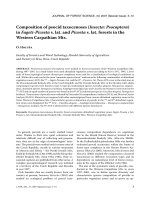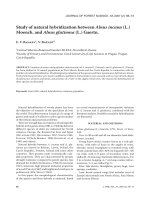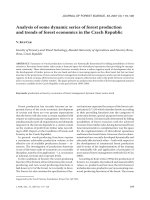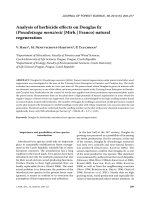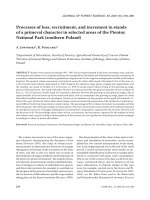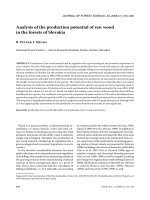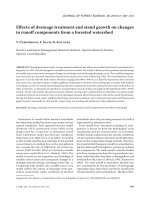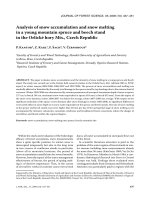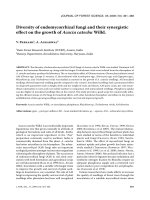Báo cáo lâm nghiệp: "Analysis of snow accumulation and snow melting in a young mountain spruce and beech stand in the Orlické hory Mts., Czech Republic" pptx
Bạn đang xem bản rút gọn của tài liệu. Xem và tải ngay bản đầy đủ của tài liệu tại đây (382.56 KB, 15 trang )
J. FOR. SCI., 55, 2009 (10): 437–451 437
JOURNAL OF FOREST SCIENCE, 55, 2009 (10): 437–451
Within the study and evaluation of the hydrologic
efficacy of forest ecosystems, snow measurements
show a quite specific position. In winter, snow is
intercepted temporarily but also in the long term
in tree crowns of coniferous stands in particular.
Above all in mountain locations, the period of
snow accumulation usually lasts for several months.
However, from the aspect of the water-management
effectiveness of forests, the period of spring melt-
ing is of decisive importance. us, in the course
of several few weeks (in extreme cases even several
days), all water accumulated in snowpack flows out
of the forest.
In scientific literature attention is paid to the
problem of the water regime of forest stands in win-
ter seasons including snow measurements already
for more than 50 years (K 1969; V
1974). In Hannover Münden in March 1984, a con-
ference Hydrological Research into Snow in Central
Europe was held. Findings there evaluated were
coming particularly from Germany and Switzerland.
Attention was particularly paid to regions with the
Supported by the Ministry of Education, Youth and Sports of the Czech Republic, the Research Plan of the Faculty of Forestry
and Wood Technology, Mendel University of Agriculture and Forestry in Brno No. MSM 6215648902, the Ministry of Agricul-
ture of the Czech Republic, Research Plan No. 0002070201, Project No. 1G 57016 and Project QH 92073.
Analysis of snow accumulation and snow melting
in a young mountain spruce and beech stand
in the Orlické hory Mts., Czech Republic
P. K
1
, Z. K
1
, F. Š
2
, V. Č
2
1
Faculty of Forestry and Wood Technology, Mendel University of Agriculture and Forestry
in Brno, Brno, Czech Republic
2
Research Institute of Forestry and Game Management, Strnady, Opočno Research Station,
Opočno, Czech Republic
ABSTRACT: e paper evaluates snow accumulation and the intensity of snow melting in a young spruce and beech
stand. e study was carried out at the Deštné field research station in the Orlické hory Mts. (altitude 900 m, WSW
aspect) in winter seasons 2005/2006, 2006/2007 and 2007/2008. e process of snow accumulation and melting was
markedly affected or disturbed by the nearly total damage to the spruce stand by top breakage due to the extreme load of
wet snow. Winter 2005/2006 was characterized by extreme parameters of snowpack (maximum depth of snow in spruce
157 cm, in beech 164 cm, maximum snow water equivalent in spruce 819 mm, in beech 833 mm). From the aspect of
the snow cover duration, winter 2006/2007 was below the average, winter 2007/2008 was average. With respect to the
significant reduction of the spruce crown biomass after snow breakage in winter 2005/2006, no significant differences
were noted either in snow depth or in snow water equivalent in the spruce and beech stands. e rate of snow melting
in the spruce and beech stands was never higher than 50 mm per day. If the spring final stage of snow melting is not
accompanied by intensive rainstorms, mountain coniferous and broadleaved forest ecosystems reduce the danger of
stormflows and floods within the required degree.
Keywords: snow accumulation; snow melting rate; spruce; beech; mountain site
438 J. FOR. SCI., 55, 2009 (10): 437–451
significant creation of snowpack, especially moun-
tain locations.
It has been proved through long-term measure-
ments that parameters of the snowpack (snow depth,
snow water equivalent) are always higher in open
space than in spruce stands, namely by 15–50%
(B 1984; I 1984; B et al.
1984; E, S 1984; K-
-K, S 1984). On the other
hand, snow water equivalent in beech stands is the
same or even higher than in open space (B
1984). The snow melting rate is unambiguously
higher on clear-cut areas and thus, it is possible to
conclude that the forest exerts significant effects on
the retardation and prolongation of the spring snow
melting. Similar results were also proved in later
studies (M et al. 1997; H, Š
2007; H et al. 2007).
Generally, forest soils are in so far permeable that
they are able to receive all water from snowmelt
including potential rainfall without the origin of sur-
face runoff. In mountain locations of Central Europe,
freezing of the soil is quite exceptional because of the
occurrence of early and continuous snow cover and
practically not affecting soil retention (S
1984). Even in Finland, freezing of the soil is negligi-
ble in forests as well as on clear-cut areas if snow falls
already in autumn and maintains a sufficient depth
(K, P 1982).
In the Czech Republic, Z (1954) referred to
the exceptional importance of snowpack as early as
in the 50
th
of the last century. Results of snow meas-
urement studies in the Beskids showed that the snow
depth was on average 63% higher in beech stands
and the snow water equivalent 75% higher than in
spruce stands.
In the Orlické hory Mts. on the Šerlich mountain-
side, K et al. (1971) investigated parameters
of snowpack in a mature fully stocked spruce stand
within the research into water regime of regenera-
tion cuts. In the course of snowfall in spruce stands,
the interception of solid precipitation occurred
in crowns of trees representing up to 40% of new
snow. Snow observations showed that about /₄ of
that initial interception loss reached the ground.
K (1973) also reported that coniferous
mountain forests retained snow for a substantially
longer period than the open area and that they par-
ticipated effectively in the prolongation of the period
of spring runoff.
In the Orlické hory Mts. at the Deštné field re-
search station, the accumulation and intensity of
snow melting have continually been studied within
a broad research programme in an experimental
spruce and beech stand since the winter season
1976/1977. Results of these studies were published in
three original scientific papers (K 1979, 1988;
K, Š 2002). Due to the different intercep-
tion process of snow precipitation in the spruce and
beech stands, snow depth and snow water equivalent
were always higher in the leafless broadleaved stand.
At the same time, it has been proved that the rate of
snow melting is always significantly higher in beech
(K 1988).
e presented paper is the fourth report analyzing
the depth/weight investigation of snowpack at this
field research station. It includes three winter sea-
sons: 2005/2006, 2006/2007 and 2007/2008.
Characteristics of the field research station
and methods of the study
e field research station was established in 1976
in a mature spruce and beech stand in the district of
Deštné in the Orlické hory Mts. Since 1. 11. 1976,
all components of the water balance of both stands
have been studied in an uninterrupted series (inter-
ception, transpiration, evaporation, overland flow,
lateral flow of water through soil (interflow), verti-
cal flow to bedrock, soil water content, and snow
measurement). Both stands are situated near apart
from each other on a WSW slope, mean inclination
16°, altitude 890 m. e depth/weight measurement
of snowpack in the mature spruce and beech stands
was carried out in five successive winter seasons
(1976/1977 to 1980/1981). In winter 1981/1982,
both stands were clear cut and in the following year,
planned harvest cutting was concentrated also into
neighbouring stands. New clear cuts of an area of
about 20 ha were reforested by spruce and beech
immediately after logging.
Since 1982/1983, the uninterrupted study of par-
ticular components of the water balance of both tree
species has continued in newly established stands.
us, the 32-year remarkable series of findings is
available on the water balance of spruce and beech
in mid-mountain locations at present. Detailed
methodology and results of studies have already
been published in a number of papers (e.g. K
1984, 1995). In winter and in the period of spring
melting, overland and lateral flow of water through
soil (interflow) was also measured on runoff plots of
a size 20 m
2
in both stands.
e presented study shows only a fragment of
those results, namely the comparison of snow
measurement studies in a young spruce and a young
beech stand (age 25 to 27 years) in winter seasons
2005/2006, 2006/2007 and 2007/2008.
J. FOR. SCI., 55, 2009 (10): 437–451 439
Table 1. Basic parameters of snow cover at the permanent field research station Deštné in the spruce and beech stands
in the winter period 2005/2006
Date of
measurements
Precipitation
(mm)
Type of
precipitation
Stand
Snow cover parameters
depth
(cm)
snow water
equivalent (mm)
density
(g/cm
3
)
22. 11.
2005
34.0
*
spruce 25.3 24.8 0.098
beech 27.0 28.4 0.105
28. 11.
2005
28.0
*
spruce 19.8 29.8 0.150
beech 23.5 48.0 0.204
9. 12. 2005 53.0
●
*
spruce 38.5 51.2 0.133
beech 46.8 57.2 0.122
15. 12.
2005
64.2
●
*
spruce 39.7 66.0 0.166
beech 42.0 69.6 0.166
23. 12.
2005
90.8
*
spruce 92.2 192.3 0.209
beech 94.0 198.1 0.211
30. 12.
2005
26.4
●
*
spruce 91.4 167.2 0.183
beech 104.7 206.9 0.198
4. 1. 2006 73.0
*
spruce 105.3 212.3 0.202
beech 108.6 223.1 0.205
12. 1. 2006 0.0
spruce 106.3 289.9 0.273
beech 111.7 298.7 0.267
24. 1. 2006 128.0
*
spruce 120.0 424.3 0.354
beech 128.5 451.9 0.352
30. 1. 2006 0.0
spruce 115.7 362.5 0.313
beech 118.3 389.1 0.329
9. 2. 2006 158.4
*
spruce 147.4 455.1 0.309
beech 148.6 475.1 0.320
18. 2. 2006 17.0
●
*
spruce 138.4 481.3 0.348
beech 142.3 495.9 0.348
27. 2. 2006 95.0
*
spruce 148.4 561.8 0.379
beech 152.4 602.6 0.395
6. 3. 2006 19.0
*
spruce 156.3 608.6 0.389
beech 157.9 613.8 0.389
13. 3. 2006 182.2
*
spruce 157.2 819.0 0.496
beech 164.1 832.7 0.537
20. 3. 2006 25.0
●
spruce 132.0 526.3 0.399
beech 144.6 550.6 0.381
27. 3. 2006 63.0
●
*
spruce 123.5 483.9 0.392
beech 133.1 520.3 0.391
10 .4. 2006 71.6
●
*
spruce 91.5 295.9 0.323
beech 67.5 249.5 0.370
440 J. FOR. SCI., 55, 2009 (10): 437–451
Table 1. to be continued
Date of
measurements
Precipitation
(mm)
Type of
precipitation
Stand
Snow cover parameters
depth
(cm)
snow water
equivalent (mm)
density
(g/cm
3
)
18 .4. 2006 0.0
spruce 67.5 275.1 0.407
beech 46.8 228.3 0.488
19. 4. 2006 0.0
spruce 61.7 268.3 0.435
beech 46.5 209.9 0.452
20. 4. 2006 0.0
spruce 61.3 251.2 0.410
beech 41.1 184.8 0.450
21. 4. 2006 0.0
spruce 56.5 234.5 0.415
beech 35.1 159.7 0.455
22. 4. 2006 0.0
spruce 47.7 216.3 0.454
beech 28.4 134.8 0.475
23. 4. 2006 0.0
spruce 42.8 199.5 0.466
beech 19.1 90.8 0.475
24. 4. 2006 0.0
spruce 42.4 181.9 0.428
beech 9.5 42.2 0.444
25. 4. 2006 0.0
spruce 31.6 137.6 0.435
beech 1.8 7.2 0.400
26. 4. 2006 0.7
●
spruce 20.0 95.0 0.475
beech
27. 4. 2006 0.0
spruce 11.1 48.6 0.432
beech
28. 4. 2006 0.0
spruce 2.3 10.2 0.443
beech
● rain;
*
snow; ●
*
rain and snow
Statistical significance of differences in the snow water equivalent in the spruce and beech stands in the period of snow
accumulation (22. 11. 2005 to 13. 3. 2006). Paired t-test at the level of significance 0.05
Stand Mean
Standard deviation
of sample
Difference
Standard deviation
of differences
t p Significance
Spruce 316.41 240.21
Beech 332.74 243.79 –16.33 12.41 –5.10 0.00 yes
e process of snow accumulation and melting
was markedly affected or disturbed in the assessed
period by the practically total damage to the spruce
stand due to top breakages in winter 2005/2006 in
consequence of extreme load by wet snow. Snow-
storms (e.g. in the first decade of February 158 mm,
in a week from 6 March to 13 March even 182 mm)
damaged up to 98% of spruce trees. In some cases,
it referred only to top breakages but in about 50% of
trees only 2 to 3 whorls of branches remained living
on tree stems.
e beech stand was disturbed to a substantially
lesser extent. Due to the snow load, about 10% of
subdominant trees with the unfavourable slender-
ness ratio were bent or broken irreversibly. ese
trees were already removed from the stand. us,
J. FOR. SCI., 55, 2009 (10): 437–451 441
the situation in the spruce stand has to be taken
into account at interpreting and analyzing results of
depth/weight measurements of the snowpack.
For the actual measurement of snow a verified
standard method of sampling snow by the depth/
weight snow core measurement device was used
(the sampler circular cross section 50 cm
2
). In all
three winter seasons, snow core samples were taken
in weekly intervals always from five sites (3 samples
from each of the sites) in a spruce and beech stand.
e depth of the samples was measured, their weight
was determined and the snow water equivalent and
snow density were calculated.
Moreover, in spring 2006 in the period of final
snowmelt, with respect to the extremely deep snow
cover a daily frequency of measurements was used
from 10 April.
In winter seasons 2006/2007 and 2007/2008, the
measurement was extended by snow sampling even
in open space.
Precipitation was measured with a rain gauge of
circular cross-section 500 cm
2
on two “open areas”
(stand gaps 20 × 30 m and 30 × 50 m) in the immedi-
ate vicinity of both stands. In the periods of snow ac-
cumulation when the air temperature did not exceed
0 degrees C, precipitation could be simultaneously
determined also from differences in the snow water
equivalent.
Differences in the snow water equivalent in the
spruce and beech stands were statistically evaluated
by paired t-test for dependent samples.
RESULTS AND DISCUSSION
From the aspect of the depth of snow precipita-
tion and duration of snow cover the winter season
2005/2006 was markedly above-average. On the
contrary, the winter season 2006/2007 was mark-
edly subnormal. Thus, the last evaluated winter
2007/2008 can be characterized as average. In the
following text, each of the winter seasons is evalu-
ated separately.
Winter season 2005/2006
All basic data on snow measurements in the winter
season 2005/2006 carried out at the long-term field
research station Deštné are given in Table 1.
The assessed season was characterized by ex-
tremely high mainly snow precipitation and by the
very long period of continuous snow cover. e first
snow fell there on 20 November 2005 and melted in
beech on 25 April 2006 (157 days with continuous
snow cover). In spruce, snow melted 3 days later,
i.e. 28 April 2006 (160 days with continuous snow
cover).
e period of snow accumulation
(from 20. 11. 2005 to 13. 3. 2006)
At the first measurement on 22. 11. 2005, the depth
of powder snow recorded in spruce equalled 25.3 cm
and in beech 27.0 cm. With progressing winter,
the snow depth gradually increased (30. 12. 2005:
spruce 91.4 cm, beech 104.7 cm; 24. 1. 2006: spruce
120.0 cm, beech 128.5 cm) until it reached its maxi
-
mum on 13. 3. 2006 – in spruce 157.2 cm, in beech
164.1 cm. During the whole period, the snow depth
in spruce was always a little lower (by 1 to 13 cm)
than in beech (see Fig. 1).
e snow water equivalent showed a similar trend
like snow depth in the assessed season (see Fig. 2).
From the aspect of hydrologic efficacy, this param-
eter shows a higher informative value than the snow
depth. From the initial value at the first measurement
on 22. 11. 2005 (spruce 24.8 mm, beech 28.4 mm) it
Fig. 1. e depth of snow in the
period of snow accumulation
(22. 11. 2005 to 13. 3. 2006)
0
20
40
60
80
100
120
140
160
180
22.11.2005
9.12.
23.12.
4.1.2006
24.1.
9.2.
27.2.
13.3.
Snow depth (cm)
-10.0
-7.5
-5.0
-2.5
0.0
2.5
5.0
7.5
10.0
12.5
Air temperature (°C)
spruce beech
0
20
40
60
80
100
120
140
160
180
22.11.2005
9.12.
23.12.
4.1.2006
24.1.
9.2.
27.2.
13.3.
Snow depth (cm)
-10.0
-7.5
-5.0
-2.5
0.0
2.5
5.0
7.5
10.0
12.5
Air temperature (°C)
spruce beech
22. 11. 2005
9. 12.
23. 12.
4. 1. 2006
24. 1.
9. 2.
27. 2.
13. 3.
442 J. FOR. SCI., 55, 2009 (10): 437–451
gradually increased (30. 12. 2005: spruce 167.2 mm,
beech 206.9 mm; 24. 1. 2006: spruce 424.3 mm,
beech 451.9 mm) up to respectable 819.0 mm in
spruce and 832.7 mm in beech on 13. 3. 2006.
e importance of the “temporary” interception of
snow precipitation results from Table 1. For example,
at the first two measurements in November, the pre-
cipitation of an open area amounted to 56 mm, but
practically 50% of snow (26.2 mm) was intercepted
in crowns of spruce trees. During winter, more than
100 mm snow precipitation was even temporarily
intercepted in tree crowns. is snow fell for the
most part to the soil surface sooner or later but its
spatial variability was great and these values have to
be regarded as approximations. For example, from
4 January to 24 January, precipitation amounting
to 128 mm was recorded on the open area but the
storage of water in snow increased by 212 mm or
229 mm. Especially high amounts of snow inter
-
cepted in tree crowns were the cause of the total
damage to a spruce stand by top breakages.
e quite exceptional winter 2005/2006 is dis-
tinguished as compared with data from 1976/1977
to 1986/1987 (Table 2). Particularly the maximum
Table 2. Snow measurement studies at the field research station Deštné in winter seasons 1976/1977 to 1986/1987 and
in the winter season 2005/2006
Winter
season
Stand
Number of days
with snow cover
Snow cover parameters
maximum depth
(cm)
maximum snow water
equivalent (mm)
mean density
(g/cm
3
)
1976/1977
spruce 124 63.1 170.2 0.266
beech 129 81.7 245.0 0.266
1977/1978
spruce 141 67.2 174.9 0.276
beech 146 83.7 222.2 0.284
1978/1979
spruce 140 47.9 146.8 0.252
beech 141 69.7 211.8 0.275
1979/1980
spruce 142 43.6 120.8 0.257
beech 142 63.8 189.4 0.276
1980/1981
spruce 117 78.3 242.1 0.290
beech 120 113.5 309.9 0.291
1986/1987
spruce 120 84.0 268.5 0.295
beech 126 124.6 406.5 0.298
2005/2006
spruce 160 157.2 819.0 0.427
beech 157 164.1 832.7 0.445
Fig. 2. e snow water equiva-
lent in the period of snow
accumulation (22. 11. 2005 to
13. 3. 2006)
0
100
200
300
400
500
600
700
800
900
22.11.2005
9.12.
23.12.
4.1.2006
24.1.
9.2.
27.2.
13.3.
Snow water equivalent (mm)
-10.0
-7.5
-5.0
-2.5
0.0
2.5
5.0
7.5
10.0
12.5
Air temperature (°C)
spruce beech
0
20
40
60
80
100
120
140
160
180
22.11.2005
9.12.
23.12.
4.1.2006
24.1.
9.2.
27.2.
13.3.
Snow depth (cm)
-10.0
-7.5
-5.0
-2.5
0.0
2.5
5.0
7.5
10.0
12.5
Air temperature (°C)
spruce beech
22. 11. 2005
9. 12.
23. 12.
4. 1. 2006
24. 1.
9. 2.
27. 2.
13. 3.
J. FOR. SCI., 55, 2009 (10): 437–451 443
Table 3. Snow-cover parameters in the period of snow melting in spring 2006
Date Stand Snow depth (cm)
Snow water
equivalent (mm)
Intensity of snow melting
(mm/day)
Average daily air
temperature (°C)
13. 3. 2006
spruce 157.2 819.0
spruce 41.8 beech 40.3
beech 164.1 832.7
20. 3. 2006
spruce 132.0 526.3
spruce 6.1 beech 4.3
beech 144.6 550.6
27. 3. 2006
spruce 123.5 483.9
spruce 13.4 beech 19.3
beech 133.1 520.3
10. 4. 2006
spruce 91.5 295.9
spruce 2.6 beech 2.7
beech 67.5 249.5
18. 4. 2006
spruce 67.5 275.1
spruce 6.8 beech 18.4 4.5
beech 46.8 228.3
19. 4. 2006
spruce 61.7 268.3
spruce 17.1 beech 25.1 5.9
beech 46.5 209.9
20. 4. 2006
spruce 61.3 251.2
spruce 16.7 beech 25.1 7.8
beech 41.1 184.8
21. 4. 2006
spruce 56.5 234.5
spruce 18.2 beech 24.9 8.9
beech 35.1 159.7
22. 4. 2006
spruce 47.7 216.3
spruce 16.8 beech 44.0 10.8
beech 28.4 134.8
23. 4. 2006
spruce 42.8 199.5
spruce 17.6 beech 48.6 7.3
beech 19.1 90.8
24. 4. 2006
spruce 42.4 181.9
spruce 44.3 beech 35.0 8.9
beech 9.5 42.2
25. 4. 2006
spruce 31.6 137.6
spruce 42.6 beech 7.2 11.3
beech 1.8 7.2
26. 4. 2006
spruce 20.0 95.0
spruce 47.0 11.5
beech
27. 4. 2006
spruce 11.1 48.0
spruce 37.8 11.9
beech
28. 4. 2006
spruce 2.3 10.2
8.3
beech
Statistical significance of differences in the snow water equivalent in the spruce and beech stands in the period of snow
melting (10. 4. to 28. 4. 2006). Paired t-test at the level of significance 0.05
Stand Mean
Standard deviation
of sample
Difference
Standard deviation
of differences
t p Significance
Spruce 184.51 92.88
Beech 108.93 97.20 75.58 37.76 6.93 0.00 yes
444 J. FOR. SCI., 55, 2009 (10): 437–451
snow water equivalent in the last winter amounting
to more than 800 mm exceeds 2× to 6× the values
given in Table 2.
Relatively small (at the limit of statistical signifi-
cance) differences in depth but particularly in the
snow water equivalent in both compared stands can
be considered to be the most important and some-
what unexpected finding from depth/weight meas-
urements in the period of snow accumulation at the
Deštné field research station in winter 2005/2006.
Because of the important interception of even winter
precipitation in spruce stands, both basic values of
snow are generally markedly higher in the leafless
beech stand (Z 1954; B 1984). is
fact is also documented by data from Table 2 (K-
1988). In our case, high values of the snow depth
and snow water equivalent in the coniferous stand
can be ascribed to the already mentioned extensive
snow breakage when due to top and stem breakages
the biomass of crowns was reduced by about 50%.
Subsequently, under the crowns of spruce stand,
such an amount of solid precipitation occurred that
was practically comparable with solid precipitation
in the beech stand.
e period of snow melting
(from 13. 3. to 28. 4. 2006)
e period of snow accumulation culminated at
the field research station Deštné in the assessed win-
ter season in mid-March (13. 3. 2006) when maxi-
mum values of snow depth were recorded in both
stands (spruce 157.2 cm, beech 164.1 cm) as well
as of the snow water equivalent (spruce 819.0 mm,
beech 832.7 mm).
e second half of March (13. 3. to 27. 3. 2006) was
already characterized by the gradual melting of snow,
which was relatively very intensive particularly from
13. 3. to 20. 3. 2006 (spruce 41.8 mm, beech 40.3 mm
daily) (see Table 3).
The depth of snow decreased by 33.7 cm to
123.5 cm in spruce until the end of March, in beech
by 31.0 cm to 133.1 cm. Nevertheless, the snow water
equivalent decreased very markedly in this period,
Fig. 4. e snow water equiva-
lent in the period of snow melt-
ing (13. 3. to 28. 4. 2006)
Fig. 3. e depth of snow in the
period of snow melting (13. 3.
to 28. 4. 2006)
0
20
40
60
80
100
120
140
160
180
13.3.2006
27.3.
18.4.
20.4.
22.4.
24.4.
26.4.
28.4.
Snow depth (cm)
-10.0
-7.5
-5.0
-2.5
0.0
2.5
5.0
7.5
10.0
12.5
Air temperature (°C)
spruce beech
0
20
40
60
80
100
120
140
160
180
22.11.2005
9.12.
23.12.
4.1.2006
24.1.
9.2.
27.2.
13.3.
Snow depth (cm)
-10.0
-7.5
-5.0
-2.5
0.0
2.5
5.0
7.5
10.0
12.5
Air temperature (°C)
spruce beech
13. 3. 2006
27. 3.
18. 4.
20. 4.
22. 4.
24. 4.
26. 4.
28. 4.
-100
100
300
500
700
900
13.3.2006
27.3.
18.4.
20.4.
22.4.
24.4.
26.4.
28.4.
Snow water equivalent (mm)
-10.0
-7.5
-5.0
-2.5
0.0
2.5
5.0
7.5
10.0
12.5
Air temperature (°C)
spruce beech
0
20
40
60
80
100
120
140
160
180
22.11.2005
9.12.
23.12.
4.1.2006
24.1.
9.2.
27.2.
13.3.
Snow depth (cm)
-10.0
-7.5
-5.0
-2.5
0.0
2.5
5.0
7.5
10.0
12.5
Air temperature (°C)
spruce beech
13. 3. 2006
27. 3.
18. 4.
20. 4.
22. 4.
24. 4.
26. 4.
28. 4.
J. FOR. SCI., 55, 2009 (10): 437–451 445
Table 4. Basic parameters of snow cover at the permanent field research station Deštné in the spruce and beech stands
and in the open area in the winter period 2006/2007
Date of
measurements
Precipitation
(mm)
Type of
precipitation
Spruce stand Beech stand Open area
snow
depth
(cm)
snow
water
equivalent
(mm)
snow
depth
(cm)
snow
water
equivalent
(mm)
snow
depth
(cm)
snow
water
equivalent
(mm)
12. 12. 2006 24.2
●
*
4.7 10.2 5.8 12.0 5.9 12.9
19. 12. 2006 7.8
●
*
1.7 5.2 3.3 8.9 2.4 7.7
27. 12. 2006 11.5
*
5.1 13.4 6.3 14.9 7.2 19.2
2. 1. 2007 30.4
*
13.9 31.2 23.9 56.4 20.7 48.0
9. 1. 2007 23.0
●
– – – – – –
16. 1. 2007 20.2
●
– – – – – –
22. 1. 2007 26.4
●
– – – – – –
1. 2. 2007 112.4
*
32.5 86.0 48.6 107.8 51.5 112.4
6. 2. 2007 12.0
*
42.9 104.4 50.5 122.8 50.7 124.4
13. 2. 2007 45.6
*
44.1 142.4 51.2 160.0 53.1 170.0
21. 2. 2007 18.6
*
●
38.2 155.6 44.3 169.6 42.2 177.6
27. 2. 2007 13.4
*
●
43.0 164.8 47.1 180.0 45.9 179.6
5. 3. 2007 52.0
*
●
44.2 168.0 46.1 181.6 48.9 181.6
15. 3. 2007 17.6
●
33.2 145.2 36.6 150.4 40.6 152.4
28. 3. 2007 24.0
●
18.4 56.8 20.3 64.0 27.3 84.8
3. 4. 2007 0 – – – – 12.1 61.4
6. 4. 2007 0 – – – – – –
● rain;
∗
snow; ●
∗
rain with snow;
∗
● snow with rain
Statistical significance of differences in the snow water equivalent in the spruce and beech stands in the period of snow
accumulation (12. 12. 2006 to 5. 3. 2007). Paired t-test at the level of significance 0.05
Stand Mean
Standard deviation
of sample
Difference
Standard deviation
of differences
t p Significance
Spruce 80.38 72.66
Beech 101.40 72.46 –21.02 28.55 –2.33 0.04 yes
in spruce by 335.1 mm to 483.9 mm, in beech by
312.4 mm to 520.3 mm. In both stands, roughly the
same amount of snow melted away. In the spruce
stand, the rate of snowmelt was slightly higher in
this period.
From the aspect of hydrologic efficacy assessing
the form of runoff from melting snow is, however,
substantially more important. us, the fact when in
a coniferous as well as in a broadleaved beech stand
quite a decisive part of water from melting snow
flowed through unfrozen soil to underlying rock and
discharged to the drainage system practically with-
out damage can be considered to be exceptionally
important. Overland flow including the lateral flow
of water through soil ranged at a level of about 13 to
16 mm in both stands for the whole March 2006.
e snow melt continued depending on the course
of weather also in the first two decades of April. An
important turnover in the process of snow melting in
both stands occurred between 27. 3. and 10. 4. 2006
when because of the radiation type of weather snow
began to melt away more intensively in the leafless
beech stand (19.3 mm per day) than in the spruce
stand (13.4 mm per day).
446 J. FOR. SCI., 55, 2009 (10): 437–451
At the beginning of the final period of melting
on 18. 4. 2006, the snow depth was decreased to
67.5 cm in spruce, to 46.8 cm in beech and the snow
water equivalent in the spruce stand was reduced to
275.1 mm and in the beech stand to 228.3 mm.
In line with the presented and approved methodol-
ogy, the daily frequency of data collection was used
in the final period of snow melting from 18. 4. 2006.
All basic data from this period are given in Table 3
and Figs. 3 and 4.
In spruce, the snowpack melted until 24. 4. with a
favourable low intensity from 6.8 to 18.2 mm/day. In
the beech stand, the rate of melting was significantly
higher, particularly on 23. and 24. 4. 2006 (44.0 or
48.6 mm/day, respectively).
e most intensive melting of snowpack in the
spruce stand was registered at the last measurements
since 24. 4. when the rate of snowmelt ranged from
42.6 to 47.0 mm/day. At that time, the continuous
snow cover in the beech stand decreased and the last
snow melted away on 25. 4. 2006 in evening hours. In
the spruce stand, the last remainders of snow melted
three days later, in the evening 28. 4. 2006.
Similarly like in March, also in April practically all
water from melting snow infiltrated to the underly-
ing rock. Only 16 mm water in spruce and 17 mm in
beech flowed out in the form of overland flow in the
last winter month.
Winter season 2006/2007
Basic parameters of the snowpack in winter
2006/2007 at the long-term field research station
Deštné in the spruce and beech stands as well as in
the open area are given in Table 4 and Figs. 5 and 6.
Generally, winter 2006/2007 can be evaluated as very
mild with frequent temporary periods of thawing in
the course of snow accumulation. e total number
of days with continuous snow cover was also very
low as compared with winter periods 1976/1977 to
Fig. 5. e depth of snow at the
field research station Deštné in
winter 2006/2007
Fig. 6. e snow water equiva-
lent at the field research station
Deštné in winter 2006/2007
0
10
20
30
40
50
60
12.12.2006
27.12.
9.1.
22.1.
6.2.
21.2.
5.3.
28.3.
6.4.
Snow depth (cm)
-6
-4
-2
0
2
4
6
Air temperature (°C)
spruce beech open area
12. 12. 2006
27. 12.
9. 1. 2007.
22. 1.
6. 2.
21. 2.
5. 3.
28. 3
6. 4.
0
10
20
30
40
50
60
12.12.2006
27.12.
9.1.
22.1.
6.2.
21.2.
5.3.
28.3.
6.4.
Snow depth (cm)
-6
-4
-2
0
2
4
6
Air temperature (°C)
spruce beech open area
0
30
60
90
120
150
180
12.12.2006
27.12.
9.1.
22.1.
6.2.
21.2.
5.3.
28.3.
6.4.
Snow water equivalent (mm)
-6.0
-4.0
-2.0
0.0
2.0
4.0
6.0
Air temperature (°C)
spruce beech open area
12. 12. 2006
27. 12.
9. 1. 2007
22. 1.
6. 2.
21. 2.
5. 3.
28. 3
6. 4.
0
10
20
30
40
50
60
12.12.2006
27.12.
9.1.
22.1.
6.2.
21.2.
5.3.
28.3.
6.4.
Snow depth (cm)
-6
-4
-2
0
2
4
6
Air temperature (°C)
spruce beech open area
J. FOR. SCI., 55, 2009 (10): 437–451 447
Table 5. Basic parameters of snow cover at the permanent field research station Deštné in the spruce and beech stands
and in the open area in the winter period 2007/2008
Date of
measurements
Precipitation
(mm)
Tape of
precipitation
Spruce stand Beech stand Open area
snow depth
(cm)
snow water
equivalent
(mm)
snow depth
(cm)
snow water
equivalent
(mm)
snow depth
(cm)
snow water
equivalent
(mm)
6. 11. 2007 24.6
*
●
4.9 22.1 7.3 24.0 8.2 24.6
14. 11. 2007 55.0
●
*
21.2 53.6 24.6 69.4 30.8 80.0
20. 11. 2007 75.3
●
*
33.8 87.4 38.5 99.8 41.1 107.7
27. 11. 2007 27.1
●
0.0 0.0 0.0 0.0 0.0 0.0
4. 12. 2007 20.9
●
0.0 0.0 0.0 0.0 0.0 0.0
11. 12. 2007 32.4
●
0.0 0.0 0.0 0.0 0.0 0.0
22. 12. 2007 17.8
●
0.0 0.0 0.0 0.0 0.0 0.0
28. 12. 2007 17.1
●
*
5.2 9.0 6.6 9.5 7.3 11.6
4. 1. 2008 12.4
*
10.2 20.0 10.8 22.6 12.6 24.0
11. 1. 2008 119.0
*
33.7 116.4 37.1 122.8 45.3 148.0
18. 1. 2008 24.9
*
40.5 144.4 53.0 165.6 58.8 172.4
25. 1. 2008 8.4
●
*
48.4 120.8 33.8 82.0 45.9 112.8
1. 2. 2008 26.4
*
35.5 136.0 33.2 115.6 32.3 127.6
8. 2. 2008 13.0
●
*
32.3 124.8 37.3 137.6 43.0 145.2
15. 2. 2008 20.4
●
*
32.6 111.2 33.1 118.4 41.3 127.2
22. 2. 2008 14.7
*
36.1 127.6 40.0 141.0 47.0 156.8
29. 2. 2008 15.0
●
*
25.0 77.6 28.5 82.4 26.8 81.6
7. 3. 2008 58.4
*
33.6 130.8 36.3 134.8 37.3 107.8
14. 3. 2008 48.4
●
27.4 72.0 33.9 96.8 39.0 99.2
21. 3. 2008 38.4
●
*
26.4 71.6 27.1 61.6 43.7 116.4
28. 3. 2008 12.1
*
26.1 93.2 31.1 120.8 39.7 140.4
4. 4. 2008 36.2
*
21.8 122.8 28.7 140.0 47.3 192.0
11. 4. 2008 12.0
*
●
22.9 98.0 20.7 82.4 35.7 110.0
18. 4. 2008 23.5
●
*
16.4 73.2 18.7 84.8 40.9 160.0
25. 4. 2008 17.0
●
15.1 51.8 0.0 0.0 19.8 73.2
29. 4. 2008 0.0
0.0 0.0 0.0 0.0 0.0 0.0
● rain;
∗
snow; ●
∗
rain with snow;
∗
● snow with rain
Statistical significance of differences in the snow water equivalent in the spruce and beech stands in the period of snow
accumulation (6. 11. 2007 to 4. 4. 2008). Paired t-test at the level of significance 0.05
Stand Mean
Standard deviation
of sample
Difference
Standard deviation
of differences
t p Significance
Spruce 74.60 52.53
Beech 79.30 55.78 –4.70 14.71 –1.50 0.15 no
1986/1987 (see Table 2) – in the spruce and beech
stands only 80 days, in the open area 85 days.
roughout the winter season, the snow depth
as well as the snow water equivalent was generally
highest in the open area followed by the beech stand.
e smallest parameters of snow were mostly found
in the spruce stand. Nevertheless, differences in both
parameters of the snowpack both between the stands
448 J. FOR. SCI., 55, 2009 (10): 437–451
and as compared with the open area were not sub-
stantial being at the level of statistical significance.
e period of snow accumulation
(12. 2. 2006 to 5. 3. 2007)
e first snow was recorded in the experimental
stands as well as in the open area at the beginning
of the second decade of December 2006 (snow
depth 4.7 to 5.9 cm, snow water equivalent 10.2 to
12.9 mm). e snow depth as well as water storage
in snow gradually increased until the beginning of
January (snow water equivalent in spruce 31.2 mm,
in beech 56.4 mm, in the open area 48.0 mm). Nev-
ertheless, as early as after three weeks in the period
from 2. 1. to 9. 1. 2007, all snow melted. In the course
of further measurements, only rainfall occurred in
January.
us, new snow was not recorded at the Deštné
station until 1. 2. 2007 (snow depth in spruce
32.5 cm, in beech 48.6 cm, in the open area 51.5 cm;
snow water equivalent in spruce 86.0 mm, in beech
107.8 mm and in the open area 112.4 mm). In the
following weeks, both basic parameters of the snow-
pack increased till 5. 3. 2007 when they reached their
maximum values. e snow depth was practically
the same in both stands and in the open area (from
44.2 to 48.9 cm). e snow water equivalent was
slightly smaller in spruce (168.0 mm) than in beech
and in the open area (181.6 mm).
e period of snow melting
(5. 3. 2007 to 5. 4. 2007)
Snow began to melt on the experimental plots in
the assessed winter on 5. 3. 2007. In the first ten days,
the rate of snow melting was very low – in spruce on
average only 2.3 mm/day, in beech 3.1 mm/day and
in the open area 2.9 mm/day. Also in next days, snow
melted rather slowly, in a period from 15. 3. to 28. 3.
in spruce and beech on average 6.6 to 6.8 mm/day, in
the open area only 5.2 mm/day. All snow melted in
both stands on 30. 3. 2007 at the mean rate of melt-
ing 30 mm/day at the most. In the open area, snow
Fig. 7. e depth of snow at the
field research station Deštné in
winter 2007/2008
Fig. 8. e snow water equiva-
lent at the field research station
Deštné in winter 2007/2008
0
10
20
30
40
50
60
6.11.2007
27.11.
22.12.
11.1.
1.2.
22.2.
14.3.
4.4.
25.4.
Snow depth (cm)
-9
-6
-3
0
3
6
9
Air temperature (°C)
spruce beech open area
12. 11. 2007
27. 11.
22. 12.
11. 1. 2008
1. 2.
22. 2.
14. 3.
4. 4.
25. 4.
0
10
20
30
40
50
60
12.12.2006
27.12.
9.1.
22.1.
6.2.
21.2.
5.3.
28.3.
6.4.
Snow depth (cm)
-6
-4
-2
0
2
4
6
Air temperature (°C)
spruce beech open area
0
20
40
60
80
100
120
140
160
180
200
6.11.2007
27.11.
22.12.
11.1.
1.2.
22.2.
14.3.
4.4.
25.4.
Snow water equivalent (mm)
-10
-8
-6
-4
-2
0
2
4
6
8
10
Air temperature (°C)
spruce beech open area
6. 11. 2007
27. 11.
22. 12.
11. 1. 2008
1. 2.
22. 2.
14. 3.
4. 4.
25. 4.
0
10
20
30
40
50
60
12.12.2006
27.12.
9.1.
22.1.
6.2.
21.2.
5.3.
28.3.
6.4.
Snow depth (cm)
-6
-4
-2
0
2
4
6
Air temperature (°C)
spruce beech open area
J. FOR. SCI., 55, 2009 (10): 437–451 449
melted out 6 days later 5. 4. 2007 again at the mean
rate about 30 mm/day.
Winter season 2007/2008
Similarly like in previous seasons, basic parameters
of the snowpack during winter 2007/2008 are given
in Table 5 and in two diagrams (Figs. 7 and 8).
Generally, it is possible to evaluate the winter
season 2007/2008 as the season with above-average
precipitation, nevertheless, the snowpack depth in
both stands did not exceed 30 to 40 cm during the
snow accumulation and the snow water equivalent
was only exceptionally higher than 140 mm. e
predominating type of weather was cyclonal with
the frequent fluctuation of temperatures above and
below the freezing point and numerous temporary
periods of thawing. e total number of days with
the cover of snow was, however, relatively high – in
spruce and in the open in total 140 days, in beech
134 days.
Figs. 7 and 8 show that the snow depth as well as
the snow water equivalent was highest in the open
area throughout the winter season but with some
exceptions. No substantial and significant differ-
ences in the snowpack parameters were found be-
tween the spruce and beech stands in the majority
of measurements.
e period of snow accumulation
(6. 11. 2007 to 4. 4. 2008)
e first snow was noted at the Deštné field re-
search station in the assessed winter season unusu-
ally early 6. 11. 2007. At the turnover of the 2
nd
and
the 3
rd
period of November, the snow water equiva-
lent in both stands amounted to 88 to 100 mm, in the
open area even to 108 mm. Nevertheless, within next
three days, all snow melted and the cyclonal type of
weather predominated practically exclusively with
rainfall until 22. 12. 2007.
New snow was noted as late as at measurements
carried out on 28 December 2007. At rich snow but
also with rain mixed precipitation in the course of
January, the snow depth as well as the snow water
equivalent gradually increased till they reached its
maximum in both stands and in the open area on
18 or 25 January 2008: spruce – depth 48.4 cm, snow
water equivalent 144.4 mm; beech – depth 53.0 cm,
snow water equivalent 165.6 mm; open space – depth
58.8 cm, snow water equivalent 172.4 mm.
Rich precipitation in February but particularly in
March was of mixed character at the cyclonal type
of weather. Thus, the snow depth in spruce and
beech ranged from 26.1 to 36.1 cm and from 27.1 to
40.0 cm, respectively. Only in the open area, it was
generally deeper, from 26.8 to 47.0 cm. e snow
water equivalent fluctuated similarly in this period:
in spruce from 71.6 to136.0 mm, in beech from
61.6 to 141.0 mm and in the open area from 81.6 to
156.8 mm.
e period of spring melting
(from 4. 4. 2008 to 27. 4. 2008)
e 4
th
of April can be considered to be the begin-
ning of spring melting at the Deštné field research
station in winter 2007/2008. At measurements car-
ried out in the course of this day the snow water
equivalent in spruce amounted to 122.8 mm, in
beech 140.0 mm and in the open area 192.0 mm.
During the following week, the snow melting in-
tensity was favourable. In spruce, it was only 3.5 mm
per day, in beech 8.3 mm/day and in the open area
11.7 mm/day. In the next week from 11. 4. to 18. 4.,
the snow melting was reduced at very low air tem-
peratures or quite interrupted in the open area.
In the final stage of melting in the last decade of
April, the snow melting rate in spruce reached about
26 mm/day, in beech about 28 mm/day and in the
open area maximally 37 mm/day. All snow melted
in spruce and in the open area on 27 April, in beech
6 days earlier, namely on 21 April 2008.
Similarly like in previous winters the fact that quite a
predominating part of water infiltrates to the underly-
ing rock and then drains away without any damage can
be considered to be the most important finding.
These conclusions agree with findings given
in studies of K et al. (1971), K and
P (1982), S (1984), H and
Š (2007) and other authors. e surface
runoff with possibilities of erosion and subsequent
danger due to stormflows is not serious when the
overland flow did not exceed 3 to 4 mm either in
spruce or beech in April 2008.
SUMMARY AND CONCLUSION
As for winter seasons assessed in this study, depth/
weight measurements of snow carried out in winter
2005/2006 show quite an exceptional informative
value. At the Deštné long-term field research station
in the Orlické hory Mts., these seasons were char-
acterized by the extreme duration of the continu-
ous snow cover (beech 157 days, spruce 160 days).
From the aspect of precipitation they were markedly
above-average (total precipitation from 1. 11. 2005
to 30. 4. 2006 1,203.7 mm).
450 J. FOR. SCI., 55, 2009 (10): 437–451
e period of snow accumulation culminated on
13. 3. 2006 when the following maximum values were
recorded – spruce: snow depth 157.2 cm, snow water
equivalent 819.0 mm; beech: snow depth 164.1 cm,
snow water equivalent 832.7 mm. e snow water
equivalent in both stands was 2 to 6 times higher
than throughout the 30-year series of measure-
ments.
In conclusion, it is necessary to stress once more
that the process of snow accumulation and melting
was markedly affected (winter seasons 2005/2006,
2006/2007 and 2007/2008) or even disturbed in
assessed seasons by practically total damage to
the spruce stand by top breakages in February and
March due to the extreme load of wet snow.
Snowstorms (e.g. in the first decade of Febru-
ary 158 mm, in a week from 6. 3. to do 13. 3. even
182 mm) damaged up to 98% spruce trees. In some
cases, it referred only to top breakages but about in
50% of trees only 2 to 3 living whorls of branches
remained. e beech stand was damaged markedly
less. About 10% of subdominant trees with the un-
favourable slenderness ratio were irreversibly bent
or broken due to the load of snow.
With respect to the marked reduction of the
biomass of spruce crowns after snow breakages
no marked differences were noted in snow depth
or snow water equivalent in the spruce and beech
stands in the winter season 2005/2006 nor in the
following two winters in the period of snow accu-
mulation.
Snowpack investigation and calculation of daily
changes of water stored in snow enabled to estimate
also the rate of snow melting. It was not generally
markedly different in the spruce and beech stands.
Only at the end of the winter season 2005/2006, the
snow melting rate was higher, on some days mark-
edly higher in the leafless beech stand (e.g. 21 to
23 April, 2006 in beech more than 40 mm/day, in
spruce less than 20 mm/day). However, the maxi-
mum daily totals from melting snow in the spruce
and beech stands never exceeded 50 mm.
e finding that the decisive part of water from
melting snow infiltrated through unfrozen soil to the
underlying rock was also of exceptional importance. In
the spruce and beech stands, overland flow including
the lateral flow of water through soil (interflow) ranged
at a level of ± 4% of winter precipitation in 2005/2006.
In the following two winter seasons it was even lower
– maximally ± 2% of winter precipitation.
Generally, it is possible to state very favourable
hydrologic effectiveness of both types of stands in
the period of spring snow melting. It is necessary
to remind extremely high precipitation including
above-average snowpack parameters in the winter
period 2005/2006. If the spring final stage of snow
melting is not accompanied by intensive rainfall or
rainstorm, mountain coniferous and broadleaved
forest ecosystems sufficiently reduce the danger of
stormflows and floods.
Refer ences
BRECHTEL H.M.,
1984. Möglichkeiten und Grenzen einer
Steuerung der Schneeansammlung und Schneeschmelz
durch forstliche Massnahmen. In: Schneehydrologische
Forschung in Mitteleuropa. Hann. Münden 12.–15. 3. 1984,
Erweiterte Zusammenfassungen: 96–99.
BRECHTEL H.M., RAPP J., SCHEELE G
., 1984. Der Ein-
fluss des Waldes und der Landnutzung auf die Schnee
-
ansammlung und Schneeschmelze in den Hessischen
Mittelgebirgen. In: Schneehydrologische Forschung in
Mitteleuropa. Hann. Münden 12.–15. 3. 1984, Erweiterte
Zusammenfassungen: 128–129.
ERNSTBERGER H., SOKOLLEK
V., 1984. Einfluss un-
terschiedlicher Vegetationsbestände auf Schneedec-
keentwicklung und Schneeschmelzabfluss in unteren
Mittelgebirgslagen. In: Schneehydrologische Forschung in
Mitteleuropa. Hann. Münden 12.–15. 3. 1984, Erweiterte
Zusammenfassungen: 90–93.
HRIBÍK M., MAJLINGOVÁ A., ŠKVARENINA J.,
KYSELOVÁ
D., 2007. Winter snow supply in small mountain watershed
as a potentional hazard of spring flood. In: STŘELCOVÁ
K. et al. (eds), Bioclimatology and Natural Hazards. Berlin,
Springer Verlag: 119–128.
HRIBÍK M., ŠKVARENINA J.,
2007. Vplyv bukového a smre-
kového lesa v rastovej fáze žrďoviny na vytváranie sne-
hových zásob. In: ROŽNOVSKÝ J., LITSCHMANN T.,
VYSKOT I
. (eds), Klima lesa, Křtiny 11.–12. 4. 2007: 13.
IMBECK H
., 1984. Schneeverteilung und Schneedeckenent-
wicklung in einem subalpinen Fichtenwald am Nordhang.
In: Schneehydrologische Forschung in Mitteleuropa. Hann.
Münden 12.–15. 3. 1984, Erweiterte Zusammenfassungen:
78–81.
KANTOR P.,
1979. Vliv druhové skladby lesních porostů na
ukládání a tání sněhu v horských podmínkách. Lesnictví,
25: 233–252.
KANTOR P.,
1984. Vodohospodářská funkce horských smr-
kových a bukových porostů. Lesnictví,
30: 471–490.
KANTOR P
., 1988. Vliv sněhové pokrývky na hydrickou
účinnost horských imisních oblastí. Práce VÚLHM,
72:
9–36.
KANTOR P., 1995.
Vodní režim smrkových a bukových porostů
jako podklad pro návrh druhové skladby vodohospodářsky
významných středohorských lesů. [Habilitační práce.] Brno,
MZLU, FLD: 332.
KANTOR P., ŠACH F., 2002.
Snow accumulation and melt in
a spruce stand and on a clearcut in the Orlické hory Mts.
J. FOR. SCI., 55, 2009 (10): 437–451 451
(Czech Republic). Ekológia (Bratislava), 21, Supplement
1: 122–135.
KREČMER V
., 1969. Vodohospodářské vlivy lesů. Praha,
Studijní informace ÚVTI, 4–5: 1–104.
KREČMER V
. et al., 1971. Mikroklimatický a vodní režim
obnovných sečí ve smrkových porostech středohorské ob-
lasti Orlických hor. [Závěrečná zpráva.] Jíloviště-Strnady,
VÚLHM: 54.
KREČMER V., 1973. Vazby lesa a vody v našem lesním
hospodářství. Zprávy lesnického výzkumu, 19: 2–16.
KRONFELLNERKRAUS G., SCHAFFHAUSER H.,
1984.
Schneehydrologische Untersuchungen in einem Tal-
zuschubsgebiet in Kärnten/Österreich. In: Schneehydrolo-
gische Forschung in Mitteleuropa. Hann. Münden 12.–15.
3. 1984, Erweiterte Zusammenfassungen: 110–112.
KUBIN E., POIKOLAINEN J.,
1982. Hakkaamattoman
metsän sekä eri tavoin muokatun avohakkuualan routa- ja
lumisuhteista. Folia Forestalia (Helsinki), No. 518: 24.
MAYER H., FEGER K.H., ACKERMANN B., ARMBRUSTER
M., 1997. Schneedeckenentwicklung in Fichtenwäldern
in südlichen Hochschwarzwald. Forstwissenschaftliches
Centralblatt, 116: 370–380.
SCHWARZ O.
, 1984. Ergebnisse eines forstlichen Schnee-
messdienstes in den Höhenlagen 600–1300 m ü. NN des
Nord- und Südschwarzwaldes. In: Schneehydrologische
Forschung in Mitteleuropa. Hann. Münden 12.–15. 3. 1984,
Erweiterte Zusammenfassungen: 103–106.
VALČIČÁK J., 1974. K otázke štúdia snehových zrážok v lese.
In: Vedecké práce VÚLH vo Zvolene,
19: 45–55.
ZELENÝ V., 1954. Výzkum sněhové pokrývky v lese. Sborník
ČAZV, řada B, No. 4: 475–484.
Received for publication December 22, 2008
Accepted after corrections April 24, 2009
Corresponding author:
Prof. Ing. P K, CSc., Mendelova zemědělská a lesnická univerzita v Brně, Lesnická a dřevařská fakulta,
Lesnická 37, 613 00 Brno, Česká republika
tel.: + 420 545 134 125, fax: + 420 545 211 422, e-mail:
Analýza akumulace a tání sněhu v mladém horském smrkovém a bukovém
porostu v Orlických horách, Česká republika
ABSTRAKT: Ve studii je hodnocena akumulace sněhu a intenzita tání sněhu v mladém smrkovém a bukovém porostu.
Šetření se uskutečnila na Výzkumném stacionáru Deštné v Orlických horách (900 m n. m, ZJZ expozice) v zimních
obdobích 2005/2006, 2006/2007 a 2007/2008. Proces akumulace i tání sněhu byl v posuzovaném období výrazně
ovlivněn, resp. narušen prakticky totálním poškozením smrkového porostu vrcholovými zlomy v důsledku extrémního
zatížení mokrým sněhem. Zima 2005/2006 byla charakteristická extrémně vysokými parametry sněhové pokrývky
(maximální výška sněhu ve smrku 157 cm, v buku 164 cm, maximální vodní hodnota sněhu ve smrku 819 mm, v buku
833 mm). Zima 2006/2007 byla z pohledu sněhových srážek podprůměrná, zima 2007/2008 průměrná. S ohledem
na významnou redukci biomasy korun smrků po sněhových polomech v zimě 2005/2006 tak nebyly v hodnocených
obdobích zaznamenány průkazné rozdíly jak u výšky, tak i u vodní hodnoty sněhu ve smrkovém a bukovém poros-
tu. Intenzita tání sněhu ve smrkovém a bukovém porostu nebyla nikdy vyšší než 50 mm za den. Pokud není jarní
závěrečná fáze tání sněhu doprovázena intenzivními přívalovými srážkami, tlumí horské jehličnaté i listnaté lesní
ekosystémy nebezpečí velkých vod a povodní v požadované míře.
Klíčová slova: akumulace sněhu; intenzita tání sněhu; smrk; buk; horské polohy
